Materials: single edge razor blades, Kim-wipes, 70% ethanol, ultramicrotome, chuck, trimmer stand, Epon block, small vacuum cleaner (optional), instruction manual for the ultramicrotome operation.
Procedure:
- Clean the razor blade edge with 70% ethanol on a Kim-wipe to remove any industrial oils.
- Insert the Epon block, tissue side up, into the chuck. Extend about a 1/4 to 1/3 of the block out of the chuck. Secure the block into chuck using the hexagonal tool.
- Place the chuck into the trimmer stand and secure it in, using the hexagonal tool.
- Place the trimmer onto the stage area of ultramicrotome and lock the trimmer into place.
- Look at the block surface through attached stereomicroscope of the ultramicrotome, at magnification (mag) settings of 1x to 4x.
-
Note that in one eyepiece is a built-in grid reticule. At the 1X mag setting, each individual square of the grid reticule is a 1 mm square. At 4x mag, each square becomes 250 micron square. Also note that the numbers or letters are positioned directly over the middle of each of the outer squares. This is very useful because it enables you to visually bisect a square and to further sub-divide the square, especially at the highest mag, i.e., 4x. So, for example, at 4x mag, you can measure off a distance on the block surface of about 65 microns, if desired. Or 525 microns (two squares plus 1/10 of the adjoining square). See diagram:

-
The initial trimming of the Epon block will result in a large trapezoid with about 45-degree angled sides, for thick sectioning. The sloping sides of such a trapezoid offers the most opportune angle for cutting by a glass or diamond knife. To begin, view the block surface through the stereomicroscope at 1x mag. Use the reticule to measure off the area in mm just around the tissue area. The largest trapezoid size permissible for thick sectioning with either a 4 mm diamond Histo knife or a glass knife, can be 3 mm by 3 mm. This is permissible only if it is critical to keep all of the tissue (not exceeding 3 mm x 3 mm). Otherwise, the smaller the trapezoid, the better it cuts or sections. The standard size for a trapezoid is about 0.8mm base width and up to 1 mm in height. See diagrams:
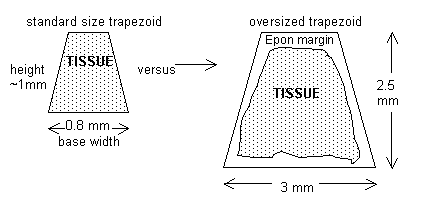
- To begin the trimming, hold the razor at a 45-degree angle (approximately) with the thumbs and forefingers.
- Start trimming the Epon furthest away from you, at a 45-degree angle. Trim the most peripheral aspect of the Epon block in a sweeping motion, from left to right (if you are right-handed or from right to left, if you are left-handed) and in small increments. Continue to trim until reaching within 1 to 1.5 mm of the tissue vicinity.
-
This facet will become either the top or bottom (or north or south) of the trapezoid. Therefore, continue to cut this side as straightly as possible. Trim as close to the tissue as needed. See diagram:
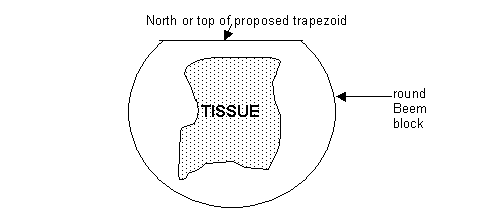
-
Rotate the chuck (or trimmer stand) 180 degrees. Begin to trim away the opposite pole (bottom or south aspect of the trapezoid) of the block, as described in steps 8 to 10. Trim this aspect as parallel as possible to the first trim. See diagram:
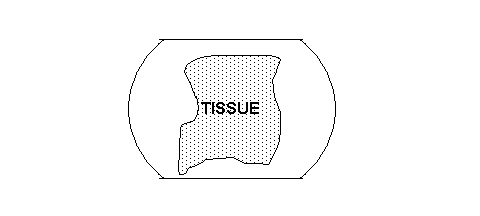
- Rotate the chuck (or trimmer stand) 90 degrees, clockwise or counter-clockwise.
-
Here, you will begin trimming the distant Epon at an angle, to either the top or bottom of the proposed trapezoid. This aspect will be the left or right side (or west or east side) of the trapezoid. See diagram:
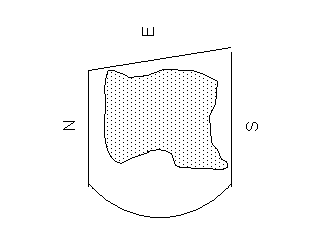
-
Rotate the block 180 degrees, perhaps counterclockwise, to access the last untrimmed area of Epon for angled trimming. Proceed to trim this area at an angle. See diagram:
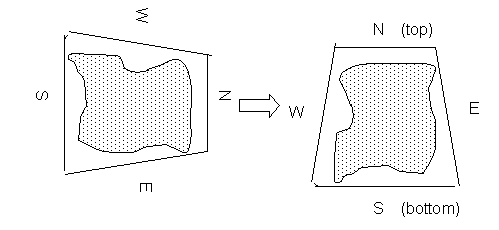
- You are now almost finished with trapezoid trimming of an Epon block. If there is a lot of over-lying Epon on the surface of the block, it is possible to very carefully trim this off with the razor blade. This takes some experience so as not to gouge into the tissue. Otherwise, the safest procedure is to trim this over-lying Epon using a glass knife or diamond Histo knife, automatically in the ultramicrotome. This is referred to as "facing" the block. See protocol on thick sectioning.
-
The above razor trimming procedure works well when the tissue has been embedded in the middle of the Epon. When the tissue has been purposely positioned at the extreme edge of a mold, such as in the flat mold, then a 3-sided trapezoid is only possible. See diagram:
